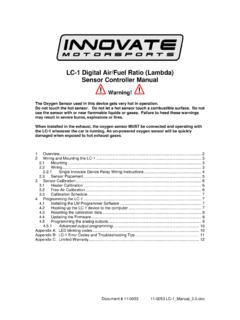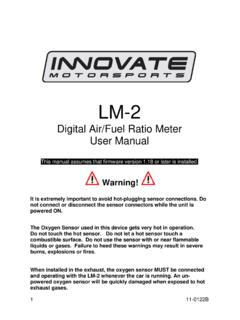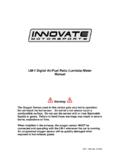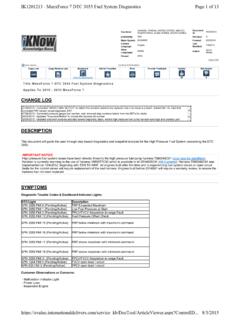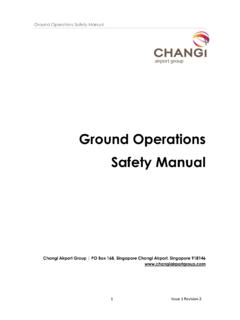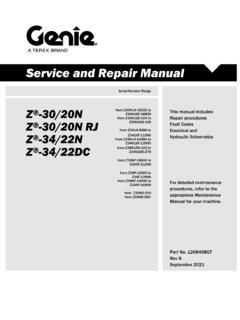Transcription of LC-2 Digital Air/Fuel Ratio (Lambda) Sensor Controller Manual
1 11-0137C LC-2 Digital Air/Fuel Ratio (Lambda) Sensor Controller Manual Warning! The Oxygen Sensor used in this device gets very hot in operation. Do not touch the hot Sensor . Do not let a hot Sensor touch a combustible surface. Do not use the Sensor with or near flammable liquids or gases. Failure to heed these warnings may result in severe burns, explosions or fires. When installed in the exhaust, the oxygen Sensor MUST be connected and operating with the LC-2 whenever the car is running. An un-powered oxygen Sensor will be quickly damaged when exposed to hot exhaust gases. 1 2 2 Mounting and Wiring the LC-2 .. 3 Mounting .. 3 Wiring .. 3 Single Innovate Device Relay Wiring Instructions.
2 4 3 Sensor Placement .. 4 4 Sensor Calibration .. 5 Calibration Schedule .. 6 5 Software (LogWorks 3 and LM Programmer) .. 7 Download the Logworks 3 software package .. 7 Installing software .. 7 Connecting to LM Programmer .. 7 Analog Outputs .. 7 Advanced output programming .. 8 Updating the Firmware .. 9 Changing Sensor Type .. 9 Logging data from your LC-2 with LogWorks .. 10 Adding and Logging MTS channels .. 10 Appendix A: Limited Warranty .. 12 Appendix B: LC-2 Error Codes and Troubleshooting Tips .. 13 2 1 LC-2 The LC-2 is a Controller that controls a wideband O2 lambda Sensor to measure O2 content in exhaust gasses. In this section we will spend a moment getting familiar with the LC-2 lambda Controller .
3 1. Status Light The LC-2 status light indicates the Controller s operational status. When the Controller is powered, the status light will light up green for 2 seconds indicating Controller initialization. After the initialization, the status light will light will blink or light up constant up to indicate one of the following operational status conditions: Light Status Definition No Light No power to the LC-2 GREEN, flashing twice a second Sensor Warm-up GREEN, series of quick flashes Sensor Calibration GREEN, solid LC-2 operational, taking readings. RED, series of flashes followed by a pause The number of flashes indicates an error condition. See Appendix for error code details. 2. Sensor Cable Connector Mates the Sensor cable to the O2 Sensor .
4 3. Wiring The LC-2 s wiring is very straight forward. All that is needed for basic installation is power (red) and ground (black). The two configurable analog output wires (one yellow and one brown) can be used to feed external Standalone ECUs, 3rd party data loggers, and AFR display gauges. 4. Serial IN & OUT Connectors The LC-2 s serial connectors are utilized when needed to program analog output settings, data log via the Logworks software with a Windows PC, or to daisy chain with other Innovate Motorsports devices. 3 2 Mounting and Wiring the LC-2 Mounting The LC-2 Controller body should be mounted inside the cabin or in another dry, protected location away from the elements. Physically mount the unit away from all ignition or stereo components and other potentially RF or EMI emitting sources.
5 Route the Sensor cable in a manner that avoids contact with the exhaust piping and other extreme heat sources that could melt the cable. Also avoid routing the Sensor cable near ignition components or other sources of RF (radio frequency) and EMI (Electromagnetic interference). Wiring The LC-2 has 4 stripped wires. 1. Connect the RED wire to an isolated switched 12V source in your vehicle. A switched 12V source goes ON as soon as key on power is active. The circuit to which you will pull power from should be able to support a 3 amp draw. Make sure this connection is protected with a 5A fuse. Circuits that share power with the vehicle s stereo, ignition system , ECU, lighting, or fuel pump should not be used.
6 When in doubt, create an additional circuit using an automotive relay available at any automotive parts supplier. See the next section for a relay installation diagram. 2. The BLACK wire should be grounded to a solid ground source. The best possible ground source would be the battery ground (-) post. If other Innovate Motorsports devices are going to be daisy-chained along with the LC-2, it is recommended that all devices be connected to a single ground point, ideally the battery ground (-) post. 3. Optionally, the YELLOW (Analog out 1) and/or BROWN (Analog out 2) can be connected to the analog inputs of other devices such as data loggers, aftermarket programmable ECUs, or AFR display gauges. If either one or both of these wires are not being used, isolate and tape the wire(s) in an out of the way location.
7 Each of the two analog output wires can connect to one device that can accept this 0-5v potential output. The default analog outputs are as follows: Analog output one (yellow) is 0V = AFR and 5V = AFR. Analog output two (brown) is = 14 AFR and .1V = 15 AFR. Note: The LC-2 s ground should share the same 4 grounding source as the device to which you are feeding the analog outputs, the easiest wait to accomplish this is to run an aux ground wire from the ground point of the LC-2 to the ground or signal ground of the device you are interfacing with. Single Innovate Device Relay Wiring Instructions 3 Sensor Placement Optimum bung placement will vary from application to application, but using the guideline below will ensure the longest Sensor life with the most accurate readings.
8 Using a bung is the preferred method for mounting the oxygen Sensor in all applications. Weld the bung at least 24 inches downstream of the exhaust port outlet (after the collector), or 24 inches after the turbocharger if so equipped. The bung should be welded before the X or H pipe if so equipped. Using a clock as reference, mount the bung between the 9:00 o clock and 3:00 o clock position. Welding the bung in the lower section of the exhaust pipe can result in Sensor damage caused by condensation making contact with the Sensor s internal heating element. 5 A 1 bung (provided in the kit) will best protect the Sensor . When fully threaded, the Sensor s tip will sit flush with the exhaust pipe, this does not adversely effect the readings.
9 The bung should always be welded before the Catalytic Converter. Welding the bung after the catalytic converter will skew the readings toward lean. The skew in readings will vary with engine load and the efficiency of the catalytic converter. Leaded fuel and two stroke applications will reduce the Sensor s life. There are many other factors that dictate the Sensor s lifespan so it is impossible to predict it s total longevity. Exhaust leaks, camshaft overlap, and open (shorty) exhausts will cause false lean readings at light engine loads. Typically, once the engine is under load and the exhaust gas volume increases, you will see accurate readings. When installed in the exhaust, the oxygen Sensor must be connected to a powered, functional LC-2 (no error codes) whenever the engine is running.
10 An un-powered Sensor will be damaged in a short period of time when exposed to exhaust gas. Do not pre-warm the Sensor before starting the engine, simply start the engine as normal. Allowing the Sensor to pre-warm before starting the engine will increase the possibility of damaging the Sensor from shock-cooling. The maximum temperature of the Sensor at the bung (the Sensor mounting location) should not exceed 500 oC or 900 oF. If these temperatures are exceeded in your application you should install the Innovate Motorsports HBX-1 heat sink bung extender. (p/n 3729.) As the O2 Sensor measures the oxygen content of the exhaust gas to provide an accurate O2 reading, even a small pin-hole leak in a poorly welded Sensor bung will effect the accuracy and performance of your O2 Sensor .
